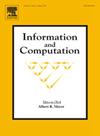Ershov等级族的Rogers半格的基数
IF 1
4区 计算机科学
Q3 COMPUTER SCIENCE, THEORY & METHODS
引用次数: 0
摘要
数论为各种可计算理论层次中的集合族提供了分类结果。编号的算法内容通常是通过编号之间的可约性来校准的。对于给定的集合族S,这种可约性产生了一个上半格的度,通常称为S的Rogers半格。本文研究了Ershov层次有限层次上集合族的Rogers半格的基性。Khutoretskii(1971)的经典结果表明,一类c.e.集合的Rogers半格要么是单元的,要么是可数无限的。Badaev和Lempp(2009)构造了一组d.c.e.集,表明对于已经处于Ershov层次第二层的Rogers半格,不能应用Khutoretskii的方法来获得类似的结果。证明了在Ershov层次的任意有限层上,对于任意有限族的集合S,相应的Rogers半格要么是单元的,要么是可数无限的。我们还得到了罗杰斯半格是无限的另一个充分条件。这个条件暗示了Badaev和Lempp的Rogers半格也是无限的。本文章由计算机程序翻译,如有差异,请以英文原文为准。
On cardinalities of Rogers semilattices for families in the Ershov hierarchy
The theory of numberings provides classification results for families of sets in various computability-theoretic hierarchies. The algorithmic content of numberings is typically calibrated via the reducibility between numberings. For a given family of sets S, this reducibility gives rise to an upper semilattice of degrees that is often called the Rogers semilattice of S.
This paper studies the cardinalities of Rogers semilattices for families of sets at finite levels of the Ershov hierarchy. The classical result of Khutoretskii (1971) shows that the Rogers semilattice of a family of c.e. sets is either one-element or countably infinite. Badaev and Lempp (2009) constructed a family of d.c.e. sets that demonstrates that the methods of Khutoretskii cannot be applied to obtain a similar result for Rogers semilattices already at the second level of the Ershov hierarchy.
We prove that for any finite family of sets S at any finite level of the Ershov hierarchy, the corresponding Rogers semilattice is either one-element or countably infinite. We also obtain another sufficient condition for a Rogers semilattice to be infinite. This condition implies that the Rogers semilattice of Badaev and Lempp is also infinite.
求助全文
通过发布文献求助,成功后即可免费获取论文全文。
去求助
来源期刊

Information and Computation
工程技术-计算机:理论方法
CiteScore
2.30
自引率
0.00%
发文量
119
审稿时长
140 days
期刊介绍:
Information and Computation welcomes original papers in all areas of theoretical computer science and computational applications of information theory. Survey articles of exceptional quality will also be considered. Particularly welcome are papers contributing new results in active theoretical areas such as
-Biological computation and computational biology-
Computational complexity-
Computer theorem-proving-
Concurrency and distributed process theory-
Cryptographic theory-
Data base theory-
Decision problems in logic-
Design and analysis of algorithms-
Discrete optimization and mathematical programming-
Inductive inference and learning theory-
Logic & constraint programming-
Program verification & model checking-
Probabilistic & Quantum computation-
Semantics of programming languages-
Symbolic computation, lambda calculus, and rewriting systems-
Types and typechecking
 求助内容:
求助内容: 应助结果提醒方式:
应助结果提醒方式:


